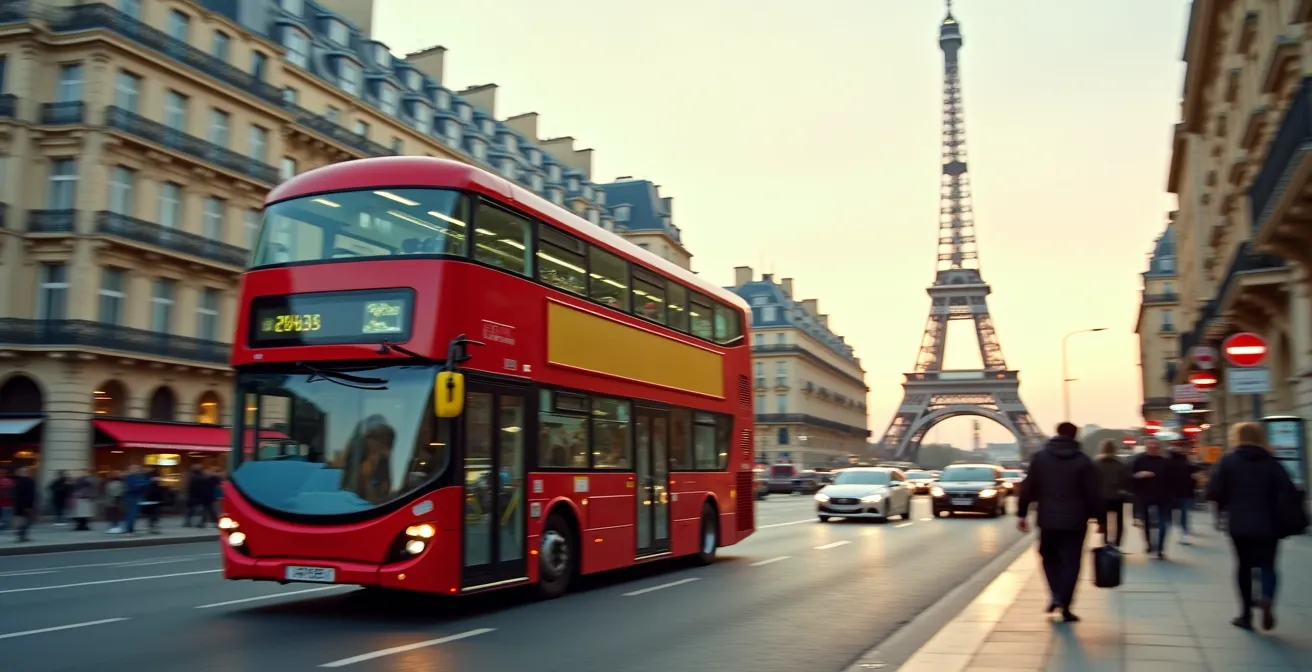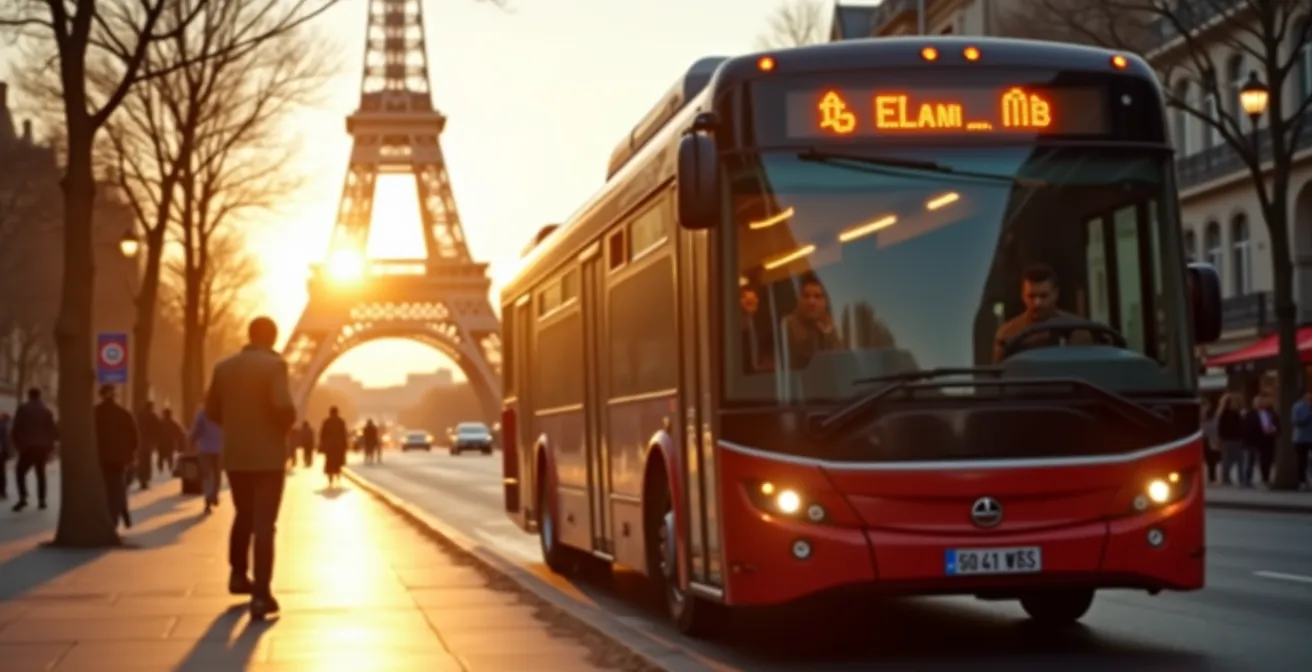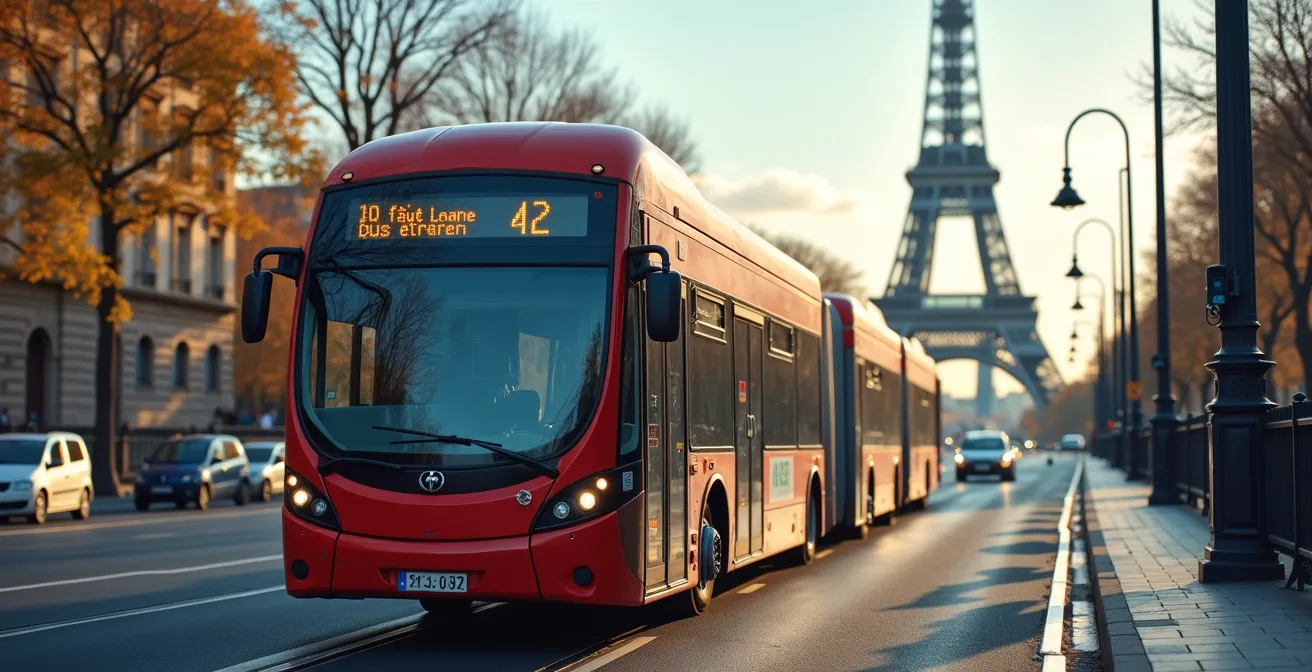
Forget the crowded Métro and the rigid schedules of typical tours. The real, breathing city of Paris unfolds at street level, from the window of a public bus. While many visitors default to structured tours, the savvy traveler knows that the city’s public bus network is the key to a more authentic, flexible, and surprisingly scenic adventure. This approach transforms simple transit into an integral part of the discovery, allowing you to experience the city’s rhythm like a true Parisian. While dedicated services like the bus tours from Tootbus.com offer a curated experience, mastering the public RATP lines unlocks a new level of freedom.
Your Parisian Bus Strategy in 4 Key Steps
- Ditch Convention: Understand why public buses often beat Hop-On Hop-Off tours for authenticity and cost.
- Master the “Sightseeing Lines”: Learn the key public routes that cover all major landmarks for the price of a single ticket.
- Architect Your Itinerary: Build a flexible 24 or 48-hour plan centered around efficient bus travel and strategic stops.
- Maximize the View: Discover which bus lines offer the most iconic perspectives and hidden scenic gems.
Beyond hop-on hop-off: choosing your efficient Parisian bus strategy
The choice between a dedicated Hop-On Hop-Off (HOHO) tour and the public bus system hinges on your travel style. HOHO tours offer simplicity and audio guides, making them a straightforward choice for first-time visitors with limited time. However, they often follow congested routes and can be significantly more expensive. In contrast, the public bus network offers a more immersive and cost-effective alternative. It’s a method favored by many, with research showing a public preference for public bus sightseeing in Paris, where 62% of travelers opt for this authentic experience.
The real advantage of the public bus is spontaneity. You travel alongside locals, discover charming neighborhoods between major sights, and have the freedom to hop off wherever curiosity strikes—not just at predetermined tourist spots. This flexibility is invaluable for short getaways, allowing for a personalized journey that a structured tour can’t replicate.
Hop-On Hop-Off tours provide convenience but the public bus system offers a more authentic and cost-effective way to discover Paris.
– Paris Tourism Board, Museum Pass Paris
To make the best choice, consider your priorities. If you value a guided, all-in-one package, HOHO is viable. If you seek adventure, authenticity, and budget-friendly travel, mastering the public bus is the superior strategy.
Comparison of Hop-On Hop-Off vs Public Bus Experience
A case study highlighting that tourists using public buses enjoyed closer interactions with Parisian daily life and saved 30% on transport costs versus Hop-On Hop-Off passengers.
This checklist will help you decide which approach best suits your trip.
Decision Factors for Bus Strategies
- Assess your time constraints: use Hop-On Hop-Off for short, comprehensive tours.
- Consider budget: public buses are more affordable.
- Evaluate your sightseeing goals: choose public buses for scenic views and local experience.
- Use apps to monitor bus timings and plan efficiently.
The “sightseeing line” strategy: mastering Paris’s public bus routes
Unlocking Paris by bus doesn’t require memorizing the entire RATP network. The secret is to focus on a few key “sightseeing lines”—public routes that pass by a remarkable number of iconic landmarks. Lines like the 42, 69, and 73 act as de facto tour routes, offering breathtaking views of the Eiffel Tower, Louvre, Champs-Élysées, and more, all for the price of a standard transit ticket. The popularity of Paris bus lines 42, 69, and 73 is clear, with over 45,000+ monthly tourists leveraging them for sightseeing.
What’s the easiest way to get bus tickets in Paris?
For tourists, the most convenient options are purchasing a Navigo Easy pass at a station to load with single tickets (t+) or using a contactless bank card to tap directly on the bus validator.
Getting started is simple. Tickets can be purchased at Métro stations or Tabac shops. For maximum flexibility, a Navigo Easy pass allows you to load multiple single-journey tickets, or you can often pay with a contactless card onboard. The key is planning your route in advance using a reliable transit app.

Navigating the system is surprisingly intuitive. Bus stops clearly display the line number and direction, and onboard screens announce upcoming stops. For a seamless journey, embrace a little passenger etiquette: board through the front doors, validate your ticket immediately, and signal your stop in advance by pressing one of the red buttons.
Here is a quick guide to getting your tickets and navigating the system.
Purchasing and Using Paris Bus Tickets
- Download the Navigo App or visit RATP website for ticket options.
- Buy single tickets or Navigo Easy passes at stations or via mobile.
- Validate your ticket onboard at the validation machine.
- Use apps like RATP or Citymapper for real-time bus tracking.
Architecting your day: a bus-centric itinerary for 24-48 hours
With a bus-centric approach, you can craft a highly efficient and enjoyable itinerary. The strategy is to group attractions geographically and use the bus not just for transit but as a scenic connector between experiences. This method minimizes travel time and maximizes sightseeing, transforming the journey itself into a highlight. By smartly linking bus routes, you can master the art of efficiently exploring major cities.
An urban mobility expert from the Big Bus Tours Official Guide suggests that “Grouping attractions by geographical proximity and using bus lines strategically can halve transit times and increase sightseeing opportunities.” This principle is key to a successful 24 or 48-hour visit. Instead of backtracking through the Métro, you can create a logical, flowing path through the city above ground.
Successful 24-Hour Tourist Bus Itinerary Review
Tourists reported seeing 10 iconic landmarks in a single day using the hop-on hop-off ticket while managing time effectively with app tracking.
A well-planned itinerary allows you to integrate short walking explorations around key bus stops. Hop off, wander through a charming side street or grab a coffee at a local café, and then catch the next bus to continue your journey. This hybrid approach offers the perfect blend of structure and spontaneity.
Here’s a sample itinerary to get you started, focusing on key lines to connect major landmarks.
Sample 1-Day Bus Itinerary
- Start at the Eiffel Tower and take Bus 42 to Champs-Élysées.
- Hop off at the Louvre Museum for a short visit.
- Rejoin the bus to Musée d’Orsay and enjoy the scenic routes via Bus 69.
- End the day at Opera Garnier or Trocadéro for evening views.
To help visualize how these routes connect the city’s main attractions, this table outlines which lines serve which landmarks, making it easier to plan your day.
| Bus Route | Main Landmarks | Ideal Time Use |
|---|---|---|
| Bus 42 | Eiffel Tower, Champs-Élysées, Gare du Nord | Morning to Afternoon |
| Bus 69 | Louvre, Orsay, Bastille | Afternoon |
| Bus 73 | Montmartre, Moulin Rouge, Sacré-Cœur | Evening |
Maximizing your views: bus routes for iconic & unexpected Paris

For a more artistic and historical route, Bus 69 is unparalleled. It elegantly connects the city’s cultural heart, linking the Louvre and Musée d’Orsay with the charming streets of the Left Bank and offering picturesque views as it travels towards the Eiffel Tower. It provides a slower, more contemplative perspective of the city.
Exclusive Tour of Bus 69 Connecting Louvre and Eiffel Tower
Bus 69 offers panoramic views of the Left Bank and passes through major Parisian museums and landmarks, recommended for cultural tourists wanting leisurely sightseeing.
Beyond these famous lines, don’t hesitate to explore lesser-known routes. Lines like the 67 can take you through vibrant, less-touristy areas like Pigalle, offering a glimpse into everyday Parisian life. The growing interest in these alternative journeys is reflected in the 20% increase from 2023 in ridership on scenic public bus routes. For a truly unique experience, you might even find yourself inspired to dive deeper into French culture and learn the art of French pastry in a local workshop discovered along your route.
This table summarizes the best routes for both iconic sights and local flavor.
| Bus Route | Iconic Stops | Description |
|---|---|---|
| Bus 42 | Eiffel Tower, Champs-Élysées, Opera Garnier | Main scenic route, popular with tourists |
| Bus 69 | Louvre, Musée d’Orsay, Eiffel Tower | Connects prominent museums and landmarks |
| Bus 67 | Pigalle, Bibliothèque Nationale, Moulin Rouge | Lesser-known, offers unique local perspectives |
Key Takeaways
- Paris’s public bus system is a cost-effective and authentic alternative to traditional tourist tours.
- Mastering a few key “sightseeing lines” like 42 and 69 covers most major landmarks efficiently.
- Strategic planning by grouping attractions geographically minimizes transit time and maximizes your experience.
- Use transit apps for real-time tracking and a Navigo Easy pass for convenient ticketing.
Frequently Asked Questions on Paris Tourism
How do I buy tickets for the Paris public bus?
Tickets can be purchased at metro stations, bus stops, or via the Navigo app and ticket machines.
Which bus routes are best for sightseeing major Paris landmarks?
Bus lines 42, 69, and 73 cover many iconic sights including the Eiffel Tower, Louvre, and Musée d’Orsay.